+ Open data
Open data
- Basic information
Basic information
| Entry | Database: PDB / ID: 7cpv | ||||||||||||
|---|---|---|---|---|---|---|---|---|---|---|---|---|---|
| Title | Cryo-EM structure of 80S ribosome from mouse testis | ||||||||||||
 Components Components |
| ||||||||||||
 Keywords Keywords | RIBOSOME / RPL39L / testis ribosome / Cryo-EM | ||||||||||||
| Function / homology |  Function and homology information Function and homology informationTNFR1-mediated ceramide production / 5.8S rRNA binding / Protein hydroxylation / positive regulation of amide metabolic process / Formation of the ternary complex, and subsequently, the 43S complex / APC/C:Cdc20 mediated degradation of Cyclin B / SCF-beta-TrCP mediated degradation of Emi1 / APC-Cdc20 mediated degradation of Nek2A / ER Quality Control Compartment (ERQC) / Regulation of PTEN localization ...TNFR1-mediated ceramide production / 5.8S rRNA binding / Protein hydroxylation / positive regulation of amide metabolic process / Formation of the ternary complex, and subsequently, the 43S complex / APC/C:Cdc20 mediated degradation of Cyclin B / SCF-beta-TrCP mediated degradation of Emi1 / APC-Cdc20 mediated degradation of Nek2A / ER Quality Control Compartment (ERQC) / Regulation of PTEN localization / Regulation of pyruvate metabolism / Downregulation of ERBB2:ERBB3 signaling / IRAK2 mediated activation of TAK1 complex / SMAD2/SMAD3:SMAD4 heterotrimer regulates transcription / PTK6 Regulates RTKs and Their Effectors AKT1 and DOK1 / Gap-filling DNA repair synthesis and ligation in GG-NER / Fanconi Anemia Pathway / Endosomal Sorting Complex Required For Transport (ESCRT) / Negative regulation of FLT3 / Synthesis of active ubiquitin: roles of E1 and E2 enzymes / Regulation of expression of SLITs and ROBOs / IRAK1 recruits IKK complex / IRAK1 recruits IKK complex upon TLR7/8 or 9 stimulation / Downregulation of ERBB4 signaling / E3 ubiquitin ligases ubiquitinate target proteins / Downregulation of TGF-beta receptor signaling / TGF-beta receptor signaling in EMT (epithelial to mesenchymal transition) / Stabilization of p53 / NOTCH3 Activation and Transmission of Signal to the Nucleus / Negative regulators of DDX58/IFIH1 signaling / Alpha-protein kinase 1 signaling pathway / Pexophagy / JNK (c-Jun kinases) phosphorylation and activation mediated by activated human TAK1 / Translesion synthesis by REV1 / Downregulation of SMAD2/3:SMAD4 transcriptional activity / Negative regulation of FGFR3 signaling / Negative regulation of FGFR4 signaling / Translesion synthesis by POLK / Formation of a pool of free 40S subunits / Regulation of NF-kappa B signaling / Negative regulation of FGFR1 signaling / Negative regulation of FGFR2 signaling / Regulation of TP53 Activity through Methylation / NRIF signals cell death from the nucleus / Translesion synthesis by POLI / Regulation of BACH1 activity / Recognition of DNA damage by PCNA-containing replication complex / SRP-dependent cotranslational protein targeting to membrane / p75NTR recruits signalling complexes / Interferon alpha/beta signaling / Negative regulation of MAPK pathway / Major pathway of rRNA processing in the nucleolus and cytosol / Spry regulation of FGF signaling / Regulation of TP53 Degradation / Nonsense Mediated Decay (NMD) independent of the Exon Junction Complex (EJC) / Translesion Synthesis by POLH / Activated NOTCH1 Transmits Signal to the Nucleus / Formation of TC-NER Pre-Incision Complex / Negative regulation of MET activity / TRAF6-mediated induction of TAK1 complex within TLR4 complex / IRAK2 mediated activation of TAK1 complex upon TLR7/8 or 9 stimulation / Termination of translesion DNA synthesis / Autodegradation of Cdh1 by Cdh1:APC/C / APC/C:Cdc20 mediated degradation of Securin / Senescence-Associated Secretory Phenotype (SASP) / Josephin domain DUBs / DNA Damage Recognition in GG-NER / Dual Incision in GG-NER / Ubiquitin-Mediated Degradation of Phosphorylated Cdc25A / Ubiquitin-dependent degradation of Cyclin D / Regulation of TBK1, IKKε (IKBKE)-mediated activation of IRF3, IRF7 / AUF1 (hnRNP D0) binds and destabilizes mRNA / Downregulation of ERBB2 signaling / Nonsense Mediated Decay (NMD) enhanced by the Exon Junction Complex (EJC) / Dual incision in TC-NER / Oncogene Induced Senescence / PINK1-PRKN Mediated Mitophagy / Cdc20:Phospho-APC/C mediated degradation of Cyclin A / SCF(Skp2)-mediated degradation of p27/p21 / N-glycan trimming in the ER and Calnexin/Calreticulin cycle / TNFR1-induced NF-kappa-B signaling pathway / Assembly of the pre-replicative complex / CDK-mediated phosphorylation and removal of Cdc6 / HDR through Homologous Recombination (HRR) / Gap-filling DNA repair synthesis and ligation in TC-NER / Translation initiation complex formation / Ribosomal scanning and start codon recognition / Inactivation of CSF3 (G-CSF) signaling / mammalian oogenesis stage / TCF dependent signaling in response to WNT / Metalloprotease DUBs / Formation of Incision Complex in GG-NER / Activation of IRF3, IRF7 mediated by TBK1, IKKε (IKBKE) / EGFR downregulation / Autodegradation of the E3 ubiquitin ligase COP1 / MAP3K8 (TPL2)-dependent MAPK1/3 activation / G2/M Checkpoints / Degradation of AXIN / Regulation of FZD by ubiquitination / Protein methylation Similarity search - Function | ||||||||||||
| Biological species |  | ||||||||||||
| Method | ELECTRON MICROSCOPY / single particle reconstruction / cryo EM / Resolution: 3.03 Å | ||||||||||||
 Authors Authors | Huo, Y.G. / He, X. / Jiang, T. / Qin, Y. / Guo, X.J. / Sha, J.H. | ||||||||||||
| Funding support |  China, 3items China, 3items
| ||||||||||||
 Citation Citation |  Journal: Nature / Year: 2022 Journal: Nature / Year: 2022Title: A male germ-cell-specific ribosome controls male fertility. Authors: Huiling Li / Yangao Huo / Xi He / Liping Yao / Hao Zhang / Yiqiang Cui / Huijuan Xiao / Wenxiu Xie / Dejiu Zhang / Yue Wang / Shu Zhang / Haixia Tu / Yiwei Cheng / Yueshuai Guo / Xintao Cao ...Authors: Huiling Li / Yangao Huo / Xi He / Liping Yao / Hao Zhang / Yiqiang Cui / Huijuan Xiao / Wenxiu Xie / Dejiu Zhang / Yue Wang / Shu Zhang / Haixia Tu / Yiwei Cheng / Yueshuai Guo / Xintao Cao / Yunfei Zhu / Tao Jiang / Xuejiang Guo / Yan Qin / Jiahao Sha /  Abstract: Ribosomes are highly sophisticated translation machines that have been demonstrated to be heterogeneous in the regulation of protein synthesis. Male germ cell development involves complex ...Ribosomes are highly sophisticated translation machines that have been demonstrated to be heterogeneous in the regulation of protein synthesis. Male germ cell development involves complex translational regulation during sperm formation. However, it remains unclear whether translation during sperm formation is performed by a specific ribosome. Here we report a ribosome with a specialized nascent polypeptide exit tunnel, Ribosome, that is assembled with the male germ-cell-specific protein RPL39L, the paralogue of core ribosome (Ribosome) protein RPL39. Deletion of Ribosome in mice causes defective sperm formation, resulting in substantially reduced fertility. Our comparison of single-particle cryo-electron microscopy structures of ribosomes from mouse kidneys and testes indicates that Ribosome features a ribosomal polypeptide exit tunnel of distinct size and charge states compared with Ribosome. Ribosome predominantly cotranslationally regulates the folding of a subset of male germ-cell-specific proteins that are essential for the formation of sperm. Moreover, we found that specialized functions of Ribosome were not replaceable by Ribosome. Taken together, identification of this sperm-specific ribosome should greatly expand our understanding of ribosome function and tissue-specific regulation of protein expression pattern in mammals. | ||||||||||||
| History |
|
- Structure visualization
Structure visualization
| Movie |
 Movie viewer Movie viewer |
|---|---|
| Structure viewer | Molecule:  Molmil Molmil Jmol/JSmol Jmol/JSmol |
- Downloads & links
Downloads & links
- Download
Download
| PDBx/mmCIF format |  7cpv.cif.gz 7cpv.cif.gz | 4.5 MB | Display |  PDBx/mmCIF format PDBx/mmCIF format |
|---|---|---|---|---|
| PDB format |  pdb7cpv.ent.gz pdb7cpv.ent.gz | Display |  PDB format PDB format | |
| PDBx/mmJSON format |  7cpv.json.gz 7cpv.json.gz | Tree view |  PDBx/mmJSON format PDBx/mmJSON format | |
| Others |  Other downloads Other downloads |
-Validation report
| Summary document |  7cpv_validation.pdf.gz 7cpv_validation.pdf.gz | 1.5 MB | Display |  wwPDB validaton report wwPDB validaton report |
|---|---|---|---|---|
| Full document |  7cpv_full_validation.pdf.gz 7cpv_full_validation.pdf.gz | 1.6 MB | Display | |
| Data in XML |  7cpv_validation.xml.gz 7cpv_validation.xml.gz | 313.4 KB | Display | |
| Data in CIF |  7cpv_validation.cif.gz 7cpv_validation.cif.gz | 554.4 KB | Display | |
| Arichive directory |  https://data.pdbj.org/pub/pdb/validation_reports/cp/7cpv https://data.pdbj.org/pub/pdb/validation_reports/cp/7cpv ftp://data.pdbj.org/pub/pdb/validation_reports/cp/7cpv ftp://data.pdbj.org/pub/pdb/validation_reports/cp/7cpv | HTTPS FTP |
-Related structure data
| Related structure data |  30433MC  7cpuC M: map data used to model this data C: citing same article ( |
|---|---|
| Similar structure data |
- Links
Links
- Assembly
Assembly
| Deposited unit | 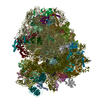
|
|---|---|
| 1 |
|
- Components
Components
+60S ribosomal protein ... , 40 types, 40 molecules LALBLCLDLELFLGLHLILJLLLMLNLOLPLQLRLSLTLULVLWLXLYLZLaLbLcLdLe...
-Protein , 3 types, 3 molecules LlLmSg
| #37: Protein | Mass: 6355.695 Da / Num. of mol.: 1 / Source method: isolated from a natural source / Source: (natural)  |
|---|---|
| #38: Protein | Mass: 14758.394 Da / Num. of mol.: 1 / Source method: isolated from a natural source / Source: (natural)  |
| #67: Protein | Mass: 35115.652 Da / Num. of mol.: 1 / Source method: isolated from a natural source / Source: (natural)  |
-Mus musculus ... , 4 types, 4 molecules L5L7L8S2
| #43: RNA chain | Mass: 1530907.375 Da / Num. of mol.: 1 / Source method: isolated from a natural source / Source: (natural)  |
|---|---|
| #44: RNA chain | Mass: 38691.914 Da / Num. of mol.: 1 / Source method: isolated from a natural source / Source: (natural)  |
| #45: RNA chain | Mass: 50795.020 Da / Num. of mol.: 1 / Source method: isolated from a natural source / Source: (natural)  |
| #46: RNA chain | Mass: 603101.938 Da / Num. of mol.: 1 / Source method: isolated from a natural source / Source: (natural)  |
+40S ribosomal protein ... , 30 types, 30 molecules SASBSDSESFSHSISKSLSPSQSRSSSTSUSVSXSaScSdSCSGSJSNSOSWSYSZSbSe
-RNA chain , 1 types, 1 molecules S6
| #78: RNA chain | Mass: 24231.510 Da / Num. of mol.: 1 / Source method: isolated from a natural source / Source: (natural)  |
|---|
-Non-polymers , 3 types, 269 molecules 




| #79: Chemical | ChemComp-MG / #80: Chemical | ChemComp-ZN / #81: Water | ChemComp-HOH / | |
|---|
-Details
| Has ligand of interest | N |
|---|
-Experimental details
-Experiment
| Experiment | Method: ELECTRON MICROSCOPY |
|---|---|
| EM experiment | Aggregation state: PARTICLE / 3D reconstruction method: single particle reconstruction |
- Sample preparation
Sample preparation
| Component | Name: Mus musculus 80S ribosome from testis / Type: RIBOSOME / Entity ID: #1-#78 / Source: NATURAL | ||||||||||||||||||||
|---|---|---|---|---|---|---|---|---|---|---|---|---|---|---|---|---|---|---|---|---|---|
| Molecular weight | Experimental value: NO | ||||||||||||||||||||
| Source (natural) | Organism:  | ||||||||||||||||||||
| Buffer solution | pH: 7.5 | ||||||||||||||||||||
| Buffer component |
| ||||||||||||||||||||
| Specimen | Embedding applied: NO / Shadowing applied: NO / Staining applied: NO / Vitrification applied: YES | ||||||||||||||||||||
| Specimen support | Grid material: GOLD / Grid mesh size: 300 divisions/in. / Grid type: Quantifoil | ||||||||||||||||||||
| Vitrification | Cryogen name: ETHANE / Humidity: 100 % / Chamber temperature: 277 K |
- Electron microscopy imaging
Electron microscopy imaging
| Experimental equipment |  Model: Titan Krios / Image courtesy: FEI Company |
|---|---|
| Microscopy | Model: FEI TITAN KRIOS |
| Electron gun | Electron source:  FIELD EMISSION GUN / Accelerating voltage: 300 kV / Illumination mode: FLOOD BEAM FIELD EMISSION GUN / Accelerating voltage: 300 kV / Illumination mode: FLOOD BEAM |
| Electron lens | Mode: BRIGHT FIELD |
| Image recording | Electron dose: 60 e/Å2 / Detector mode: SUPER-RESOLUTION / Film or detector model: GATAN K2 SUMMIT (4k x 4k) |
- Processing
Processing
| Software |
| ||||||||||||||||||||||||
|---|---|---|---|---|---|---|---|---|---|---|---|---|---|---|---|---|---|---|---|---|---|---|---|---|---|
| EM software | Name: SerialEM / Category: image acquisition | ||||||||||||||||||||||||
| CTF correction | Type: NONE | ||||||||||||||||||||||||
| 3D reconstruction | Resolution: 3.03 Å / Resolution method: FSC 0.143 CUT-OFF / Num. of particles: 100403 / Symmetry type: POINT | ||||||||||||||||||||||||
| Refinement | Cross valid method: NONE Stereochemistry target values: GeoStd + Monomer Library + CDL v1.2 | ||||||||||||||||||||||||
| Displacement parameters | Biso mean: 18.37 Å2 | ||||||||||||||||||||||||
| Refine LS restraints |
|
 Movie
Movie Controller
Controller





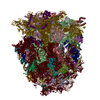
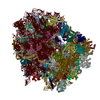


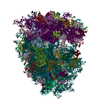
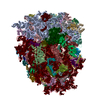
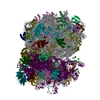

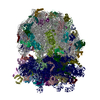
 PDBj
PDBj



















































